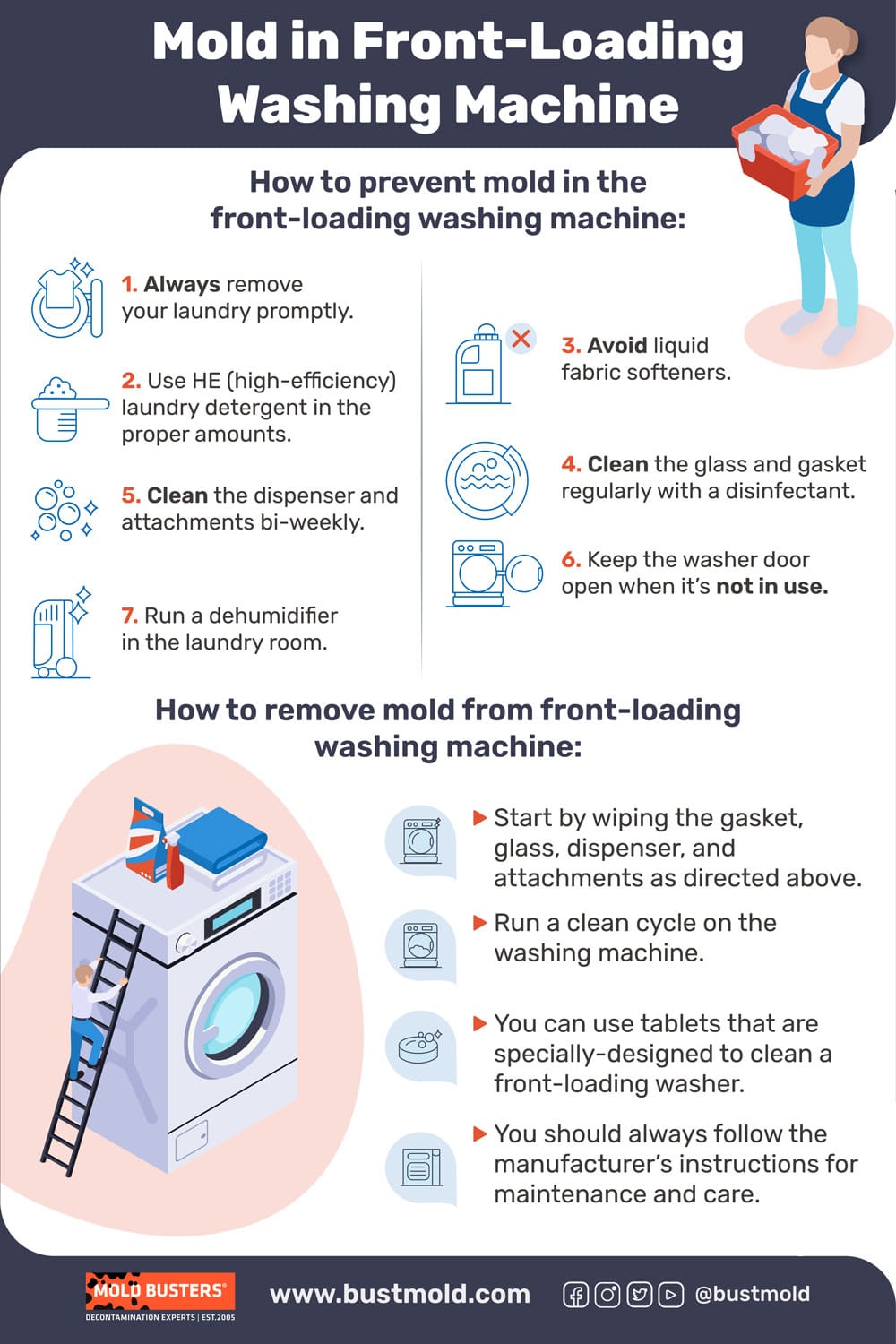Mold in Front-Loading Washing Machine
Front-loading clothes washers have been around for years now, and their efficiency helps to ensure their popularity. Buying a new home or doing a home renovation can be daunting. Hiring painters, contractors and purchasing various appliances, including a new washing machine can be very expensive.
Average washing machines usually run between $600-700, though they can cost significantly more when all is said and done. Generally speaking, though, they save enough water and energy over their lifespans to negate the extra expense over their top-loading counterparts.
So don’t stress too much about buying a new washing machine, it won’t break your bank. However, as the first batch rolls out, complaints about musty smells and mold inside the machines start rolling in.
Worried About Mold in Your Washing Machine? Get a Free Inspection!
Mold in front-loading washing machines can be a hidden hazard, posing risks to your health and damaging your appliance. Don’t let it go unchecked! Contact Mold Busters for a free virtual mold inspection. Our experts are ready to provide you with a comprehensive assessment and a plan to tackle any mold issue, ensuring your home is safe and healthy. Act now to protect your space!
Contents
It’s not you, it’s the machine (sort of)

There have been several lawsuits over this, and the company who manufactured the washing machine always seems to win. It comes back as a user-error, and the consumer is left with a defunct (and expensive) machine. A few lucky people have had their front-loaders replaced by the manufacturer when mold has been an issue, but reports like this are few and far between.
Although it’s a very common issue, the responsibility for mold usually falls upon the machine’s owner. However, the latest models are manufactured slightly differently, and fewer people are reporting mold issues in the washing machines these days. If you have one of these newer models, you’re still not out of the woods entirely. Both camps need to take precautions to prevent mold growth in their front-loading washing machines.

If you’re unsure about how to go about this, consider our virtual inspection service. And if you’re located in Montreal or Ottawa, our team can assist you in dealing with such issues.
The problem is often the gasket
The gasket is what really prevents the water inside the machine from leeching out and turning your laundry room into a swamp. Unfortunately, gaskets have so many little pockets for build-up to settle into, that they become the perfect area for mold to grow. However, mold can settle into almost any part of the machine.

Did you know?
Only 13% of bathrooms we have tested didn’t have presence of mold?! Find out more exciting mold stats and facts inside our mold statistics page.
How to prevent mold in the front-loading washing machine
- Always remove your laundry promptly. It probably goes without saying, but things can start to go south within a matter of hours.
- Use HE (high-efficiency) laundry detergent in the proper amounts. HE laundry detergent is formulated differently than the traditional variety, and it rinses away with less water. When you overdose with soap, or use the wrong kind, the machine is not capable of getting rid of all the residue, and that can cause problems with your laundry and the machine.
- Avoid liquid fabric softeners. Just like traditional soap, residue from liquid fabric softener tends to stick around.
- Clean the glass and gasket regularly with a disinfectant. Some manufacturers recommend that you do this after each and every wash cycle. Bleach mixed with water is often suggested, but that can be hard on the gasket and cause it to break down prematurely. Because of this, many people choose to use natural white vinegar instead.
- Clean the dispenser and attachments bi-weekly. It’s recommended that you use a disinfectant again, but the key here is to make sure you’re removing all the residue.
- Keep the washer door open when it’s not in use. This allows the inside to dry out, making it less-inviting to mold. If your house has children or pets who may become entrapped in the machine, secure the door to the room, or skip this method altogether.
- Run a dehumidifier in the laundry room. Removing excess moisture from the air can help prevent mold growth.
How to remove mold from front-loading washing machine
- Start by wiping the gasket, glass, dispenser, and attachments as directed above. Again, removing residue is key in preventing mold, but once you’ve got a scent or visible mold, you need to use something with a disinfectant.
- Run a clean cycle on the washing machine. Some manufacturers recommend you do this twice a month as a precautionary measure. Usually, a cycle on the hottest setting with bleach is enough to take care of the problem. Other manufacturers make tablets that are specially-designed to clean a front-loading washer. Be prepared to give it a couple of cycles if the first round fails to correct the issue.
- It’s worth noting that you should always follow the manufacturer’s instructions for maintenance and care. If the maintenance and correction methods are safe to use, according to your washer’s instruction manual, but they still don’t work, you’ll need to call in a pro. Try speaking to the manufacturer to see if they will replace the machine or send someone out. If not, find out what steps they recommend to remedy the issue.
For more expert tips about mold prevention and removal, contact the mold removal professionals

Get Special Gift: Industry-Standard Mold Removal Guidelines
Download the industry-standard guidelines that Mold Busters use in their own mold removal services, including news, tips and special offers:
Published: May 14, 2020 Updated: May 31, 2024

Written by:
John Ward
Account Executive
Mold Busters
Fact checked by:
Michael Golubev
CEO
Mold Busters
